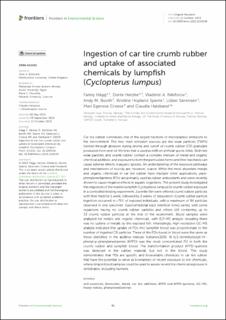| dc.contributor.author | Hägg, Fanny | |
| dc.contributor.author | Herzke, Dorte | |
| dc.contributor.author | Nikiforov, Vladimir | |
| dc.contributor.author | Booth, Andy | |
| dc.contributor.author | Sperre, Kristine Hopland | |
| dc.contributor.author | Sørensen, Lisbet | |
| dc.contributor.author | Egeness, Mari Jystad | |
| dc.contributor.author | Halsband, Claudia | |
| dc.date.accessioned | 2023-11-21T15:22:46Z | |
| dc.date.available | 2023-11-21T15:22:46Z | |
| dc.date.created | 2023-10-19T13:54:14Z | |
| dc.date.issued | 2023 | |
| dc.identifier.citation | Frontiers in Environmental Science. 2023, 11, 1219248. | en_US |
| dc.identifier.issn | 2296-665X | |
| dc.identifier.uri | https://hdl.handle.net/11250/3103923 | |
| dc.description.abstract | Car tire rubber constitutes one of the largest fractions of microplastics emissions to the environment. The two main emission sources are tire wear particles (TWPs) formed through abrasion during driving and runoff of crumb rubber (CR) granulate produced from end-of-life tires that is used as infill on artificial sports fields. Both tire wear particles and crumb rubber contain a complex mixture of metal and organic chemical additives, and exposure to both the particulate forms and their leachates can cause adverse effects in aquatic species. An understanding of the exposure pathways and mechanisms of toxicity are, however, scarce. While the most abundant metals and organic chemicals in car tire rubber have multiple other applications, para-phenylenediamines (PDs) are primarily used as rubber antioxidants and were recently shown to cause negative effects in aquatic organisms. The present study investigated the responses of the marine lumpfish (Cyclopterus lumpus) to crumb rubber exposure in a controlled feeding experiment. Juvenile fish were offered crumb rubber particles with their feed for 1 week, followed by 2 weeks of depuration. Crumb rubber particle ingestion occurred in >75% of exposed individuals, with a maximum of 84 particles observed in one specimen. Gastrointestinal tract retention times varied, with some organisms having no crumb rubber particles and others still containing up to 33 crumb rubber particles at the end of the experiment. Blood samples were analyzed for metals and organic chemicals, with ICP-MS analysis revealing there was no uptake of metals by the exposed fish. Interestingly, high resolution GC-MS analysis indicated that uptake of PDs into lumpfish blood was proportionate to the number of ingested CR particles. Three of the PDs found in blood were the same as those identified in the additive mixture Vulkanox3100. N-(1,3-dimethylbutyl)-N′-phenyl-p-phenylenediamine (6PPD) was the most concentrated PD in both the crumb rubber and lumpfish blood. The transformation product 6PPD-quinone was detected in the rubber material, but not in the blood. This study demonstrates that PDs are specific and bioavailable chemicals in car tire rubber that have the potential to serve as biomarkers of recent exposure to tire chemicals, where simple blood samples could be used to assess recent tire chemical exposure in vertebrates, including humans. | en_US |
| dc.language.iso | eng | en_US |
| dc.rights | Navngivelse 4.0 Internasjonal | * |
| dc.rights.uri | http://creativecommons.org/licenses/by/4.0/deed.no | * |
| dc.title | Ingestion of car tire crumb rubber and uptake of associated chemicals by lumpfish (Cyclopterus lumpus) | en_US |
| dc.title.alternative | Ingestion of car tire crumb rubber and uptake of associated chemicals by lumpfish (Cyclopterus lumpus) | en_US |
| dc.type | Peer reviewed | en_US |
| dc.type | Journal article | en_US |
| dc.description.version | publishedVersion | en_US |
| dc.rights.holder | © 2023 Hägg, Herzke, Nikiforov, Booth, Sperre, Sørensen, Creese and Halsband. | en_US |
| dc.source.volume | 11 | en_US |
| dc.source.journal | Frontiers in Environmental Science | en_US |
| dc.identifier.doi | 10.3389/fenvs.2023.1219248 | |
| dc.identifier.cristin | 2186403 | |
| dc.relation.project | EU – Horisont Europa (EC/HEU): 101060213 | en_US |
| dc.relation.project | Framsenteret: 581/2021 | en_US |
| dc.relation.project | Norges forskningsråd: 312262 | en_US |
| dc.relation.project | Norges forskningsråd: 311313 | en_US |
| dc.source.articlenumber | 1219248 | en_US |
| cristin.ispublished | true | |
| cristin.fulltext | original | |
| cristin.qualitycode | 1 | |

